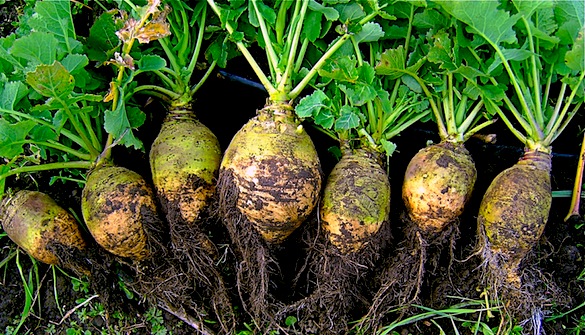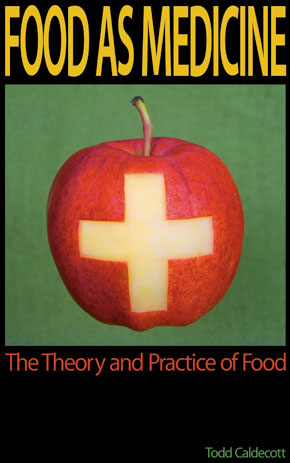Over the past couple years I have heard practitioners and patients refer to the FODMAP diet as a way to resolve chronic gut issues like irritable bowel syndrome (IBS). In a nut shell, the FODMAP diet refers to the reduction or elimination of foods that contain various long-chain sugars found in foods such as cereals, pulses, root vegetables, and fruits (see this list). Specifically, the term FODMAP is an acronym devised by researchers at Monash University in Australia, referring to foods that contain “Fermentable Oligo-saccharides, Disaccharides, Mono-saccharides and Polyols”. According to proponents of the FODMAP restriction diet, as well as similar diets such as the Specific Carbohydrate and GAPS diet, many of these sugars aren’t properly digested. As a result, they are utilized instead by some of the bacteria that naturally inhabit our intestines, leading to their enhanced growth and fermentation, causing symptoms such as gas, bloating, colic, and diarrhea. Many people following a FODMAP or Specific Carbohydrate diet do indeed find that their symptoms diminish after some time. The problem, however, is that patients quickly find that the diversity and variety of foods in their diet begins to decline dramatically. With these and other restrictions, some may feel that they have painted themselves into a corner, finding that their intolerances and sensitivities actually worsen over time, or that they experience difficult problems such as chronic constipation.
The notion that indigestible sugars can cause gas and bloating isn’t anything new. More than 20 years ago when I began my training as a herbalist, I was taught that a whole foods vegetarian diet was a healthier option than a meat-based diet, and during the first couple years of my practice I encouraged many to make this switch. One of the more common issues I observed, however, was that with the displacement of meat for vegetarian sources of protein such as beans, nuts and seeds, as well as whole grains and root vegetables, patients very often presented with an increase in gas and bloating, and sometimes even experienced diarrhea. I learned to anticipate this, and explain that it was a natural result of adding more high-fiber foods to the diet, which in turn, altered the composition of the microflora in the gut. In many cases, the symptoms of gas and bloating that accompanied these changes were temporary, and usually the symptoms would begin to diminish within a few weeks. Often I would discuss ways to improve digestibility, such proper cooking techniques, and the use of culinary herbs, such as cooking legumes with ginger and garlic. In some patients however, their digestive symptoms didn’t get better, and it was this as well as other reasons, that I soon abandoned the idea that a vegetarian diet was necessarily good or well-suited to everybody. Nonetheless, I learned a great deal about how to deal with digestive issues attributable to a high fibre diet.
It is very clear that some people do note an improvement in their digestive symptoms when they avoid FODMAP-containing foods. But before we celebrate the success of this intervention, it is important to look at some potential problems. Firstly, the FODMAP diet seeks to remove many of the high fibre foods that researchers have linked to a reduction in the risk of hypertension, stroke, elevated LDL cholesterol, ischemic heart disease, diabetes, and colorectal cancer. Some of the FODMAPs have also been shown to benefit chronic digestive disorders such as GERD, ulcer, and hemorrhoid, as well as promote mineral absorption, modulate immune function, resist infection, enhance mood and memory, and promote healthy aging. In this context, the fermentable, indigestible fibres described by the FODMAP system are also called ‘prebiotics’, meaning that they provide a substrate for the growth and development of probiotic bacteria such as Lactobacillus spp., Bifidobacterium spp. and Saccharomyces boulardii. It is well-established that these and related bacterial species promote a healthy gut, which in turn, conveys a benefit to immune and metabolic function. Further, some FODMAP foods such as onion and garlic contain powerful antitumor chemicals such as diallyl disulfide, S-allylcysteine, and ajoene, and when consumed regularly, are highly associated with a significant reduction in cancer risk. Given the weight of evidence in favor of consuming prebiotic foods, is the FODMAP-restricted diet a valid and safe approach for managing chronic digestive disease?
While it may be empirically true that in some cases a FODMAP-restricted diet promotes an improvement of symptoms, we need to ask if the benefits are only attributable to an avoidance of fermentable sugars. Upon review, many of the foods listed by researchers at Monash University as being high in FODMAPs, are also high in a plethora of other molecules that are well-established to cause problems in the gut. In my book Food As Medicine, I review the issue of antinutrient factors (ANFs) in high-fiber foods, which includes constituents such as phytic acid and polyphenols, which chelate minerals and directly inhibit digestive secretions. In the case of cereals and legumes in particular, these foods also contain toxic storage proteins such as gliadin and vicilin that promote inflammation, protease inhibitors that block the function of protein-digesting enzymes, and lectins that can induce gut inflammation and provoke autoimmune diseases. Thus it seems reasonable to challenge the conclusions made by FODMAP proponents that it is just fermentable sugars that are the problem, when in actual fact, the issue is a great deal more complicated. It is also difficult to have a great deal of faith in the FODMAP recommendations, when they state that spelt flour is low FODMAP and gluten-free, when in fact spelt is just a subspecies of wheat (Triticum aestivum subsp. spelta), and most definitely contains gluten. While there is some research showing that fermentation can reduce the gliadin content in sourdough bread, the procedure may require specific strains of bacteria (e.g. Lactobacillus sanfranciscensis) and must be fermented for up to 72 hours at 37°C, and currently, there are a serious dearth of commercial bakeries I know of that ferment their dough long enough to significantly reduce gluten. In other words, if you are following a FODMAP diet but actually have a gluten sensitivity, the recommended FODMAP diet won’t provide any benefit.
As a practitioner that has been studying global food traditions for 20 years, I am not overly impressed by the FODMAP diet and its conclusions. The meal plan is better than the Standard American Diet to be sure, but due to it’s myopic perspective I cannot consider it to be a sustainable diet. To be sure, some people have a very hard time digesting FODMAP foods. But is the solution one of simple avoidance? When we reach back into the history of our culinary traditions, it is very clear that humans have long worked out ways to deal with the digestive issues causes by FODMAPs, as they have been found in our staples for millennia. Beets for example, are a high FODMAP food, with high levels of fructans that can cause gas and bloating. When consumed irregularly, boiled or baked beets are helpful for occasional constipation, and have a laxative activity. When consumed as a staple however, the high levels of indigestible sugars in beets will eventually causes issues, and foment the creation of a gut filled with FODMAP-loving bacteria. Good news for the bacteria, but uncomfortable and bloaty for you.
The solution? Ferment the beets first. Make those same bacteria get the work done for you before you eat it. Surveying the majority of cookbooks, it appears to be a little known fact that a beet “borscht” was originally made with fermented beets – a tradition kept alive by some Jewish families of Ukrainian origin as a dish called russel. Fermentation of the beets beforehand utilizes the same FODMAP-loving bacteria we don’t want to overpopulate our gut with, effectively breaking down indigestible sugars that just cooking cannot. Among poor Jewish farmers during the 20th century Ukraine, beets were very much a staple, but without fermentation it is likely that as a staple it would have resulted in severe malnutrition. Likewise, many different cultures employed fermentation to improve the nutrient bioavailability of their food, including dairy products (e.g. yogurt), cereals (e.g. idli), legumes (e.g. natto), and seeds (e.g. cacao). Perhaps the FODMAP diet should be renamed “The Fermented Food” diet, and then the confusion will cease to persist about which foods can and cannot be eaten. Then we can go back to using prebiotic foods such as garlic and apple, as well as medicinal herbs to modulate the gut, such as Astragalus and Slippery Elm. Generally, all that we need to know about them is that when given in larger doses, prebiotics tend to stimulate a colonic response by encouraging bacterial growth, helping with issues such as constipation. But when there’s gut irritation and diarrhea, indicating bacterial overgrowth, it is wise to use less prebiotics or even eliminate them altogether as a form of population control. It’s that simple. You are in charge of your bacteria by what controlling what you eat.
But what to do with the patient that has removed so many foods from their diet, that they can hardly eat anything at all? Is it a valid therapeutic goal to have someone stuck on a FODMAP diet forever? Or is there something missing? After considering the issue of food preparation, perhaps the answer is found within the process of digestion itself. Ideally, we should all be able to eat a broad variety of properly prepared, whole foods. Dietary ratios will differ for each, based on constitutional or disease factors, and for some there may always need to be a strict avoidance of a particular food – such as gluten. But humans have been consuming high fibre foods and herbs for a very long time, and there is no rational reason why we should not be able to now. Thus a blind adherence to FODMAP, Specific Carbohydrate, and GAPS, as beneficial as they might be to a patient at a certain point in time, misses the mark completely. It’s all about digestion. One major issue that needs to be accounted for, however, is the long term effect of systemic antibiotics on the human microbiome, creating ecological distortions within gut, promoting chronic inflammation and bowel dysfunction. Restoration of a healthy gut ecology is vital, and it could be that for some patients a fecal transplant from a healthy individual is the only answer (although there is some risk of autoimmune reactions). Otherwise, the focus needs to return to digestion, and how to improve it. In future blogs and webinars, I’ll explain this process further.



